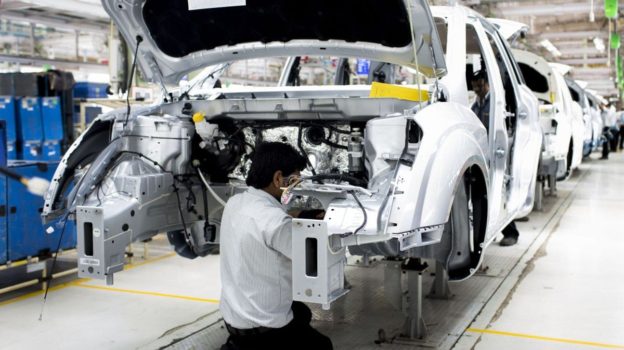‘India’s quest to expand its footprint in the manufacturing sector has shown positive results with the country coming second after China in the Global Manufacturing Risk Index 2021.’
The nation is paving its way towards ‘Atmanirbhar Bharat’, with manufacturing playing a pivotal role in steering the momentum. The sector’s share in the GDP has remained range bound, hovering at ~17 per cent for the last few years. However, a series of actions surrounding ‘Atmanirbhar Bharat’ is setting the ground to bolster the country’s manufacturing capabilities and further increase the sector’s share in the GDP. The pandemic-led disruptions in global supply chains have led the way for additional reforms, introducing policy initiatives, such as the Production Linked Incentive (PLI) scheme, to reduce trade dependency.
Pandemic-induced supply chain disruptions
The pandemic has been a wake-up call for the countries depending on Chinese suppliers. Several countries have stepped up efforts to diversify their supply chains while also reducing overdependence on one single source to keep their value chain intact. Consequently, India also ramped up its efforts to formulate policies in the form of PLI scheme, facilitating investments and building domestic manufacturing capabilities.
In March 2020, the government launched a PLI scheme for three sectors and later expanded the ambit to 13 sectors with an outlay of INR1.97 lakh crore over the next five years. The scheme aims to bring India on the global manufacturing map and can be a game changer in building domestic capabilities and drawing international investments.
The journey so far and major developments
Various sectors have already started benefitting from the incentives under the scheme. While electronic goods exports increased by 49 per cent to USD11 billion in the first three quarters of FY22, around 20 applicants have been approved under the PLI scheme for automobile. Further, 55 companies have qualified for the PLI scheme in the pharmaceutical sector.
Among other sectors, 42 companies have been approved under white goods which can lead to an incremental production of INR81,254 crore. The government has announced an additional allocation of INR19,500 crore for a PLI in manufacturing of high efficiency modules to augment solar PV manufacturing. A total of 10 bids with a capacity of ~130 Gwh have been received for Advanced Chemistry Cell (ACC) battery storage to boost electric vehicle capabilities.
Further, the government has received proposals from five companies to establish electronic chip and display manufacturing plants with an investment of INR1.53 lakh crore under the scheme, amid inadequate supply of chips globally.
Measuring success for the economy
The scheme is expected to result in the aggregate industrial capex rising 1.3 times through FY2022–2024 in comparison to FY2018–2020, generating INR2.2 lakh crore worth of capex during the scheme period.
On the GDP front, the World Bank expects India’s economy to grow by 8.7 per cent in 2022–23. The growth is significantly higher when compared to emerging peers, such as China (5.1 per cent), Indonesia (5.2 per cent) and Bangladesh (6.4 per cent), during the same period. India is expected to add 1.7 per cent to its GDP by 2027 through the scheme, generating USD150 billion in new sales.
What to expect in 2022
Given the rising interest from global manufacturers, the government is planning to launch a PLI scheme in the 5G space.
India’s quest to expand its footprint in the manufacturing sector has shown positive results with the country coming second after China in the Global Manufacturing Risk Index 2021. However, while there has been a spurring growth in India’s domestic manufacturing capabilities, there is a need for continuous monitoring and intervention to support the progress. Further, a hike in import duties on mobile components and the stiff competition in textile sector from countries such as Vietnam and Bangladesh can pose some hindrances for some sectors.
Going forward, providing easier access to land, boosting infrastructure, reducing procedural complexities, and upskilling talent would be some of the prerequisites for a seamless implementation.
https://www.financialexpress.com/industry/pli-scheme-adding-firepower-to-indias-domestic-manufacturing-capabilities/2489278/





